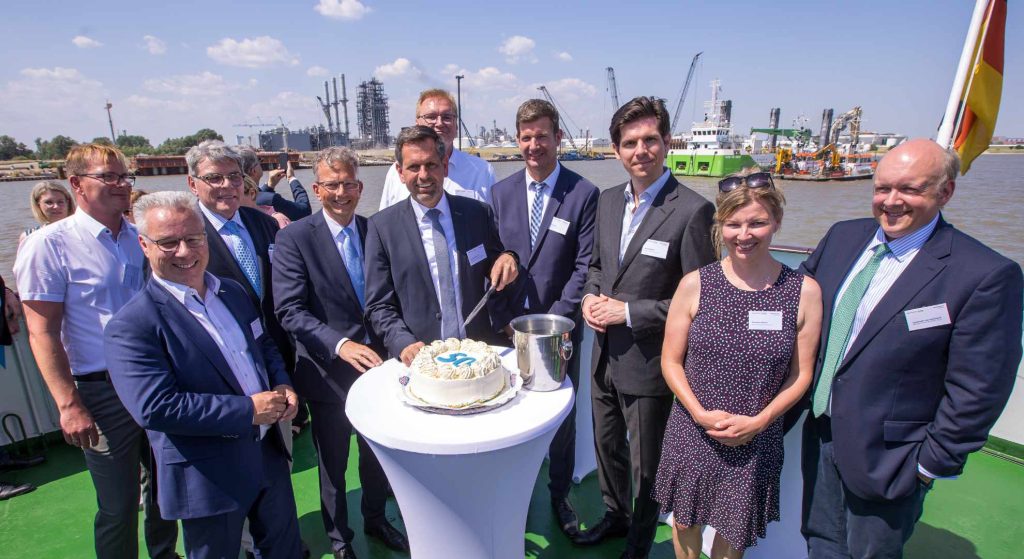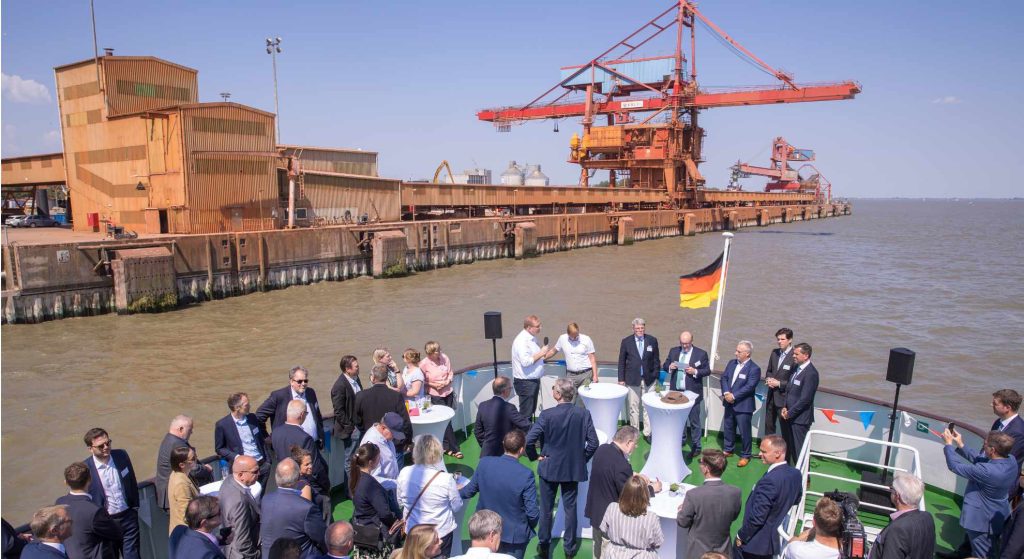Stade's port industry celebrates the 50th anniversary of the industrial port on the Elbe with Economics Minister Olaf Lies and other guests
Stade | 12. Juni 2023
Fifty years ago, it already had the essential features that a seaport location needs: On one side of the dike, water depths for large ships, and on the land side, sufficient areas for large industries to settle. Today, the seaport of Stade in northern Niedersachsen has grown and is economically integrated into the Elbe-Weser region and the Hamburg metropolitan area. In terms of throughput, it is consistently among the top 3 port locations in Niedersachsen. A total of about 2,700 people are employed in the port area.
"I congratulate Niedersachsen Ports and the seaport of Stade not only on its 50th anniversary, but rather on its excellent development and good future prospects. With an annual handling volume of almost seven million tons, Stade is an outstanding location in Niedersachsens port group. Special competence and experience in the area of hazardous goods and the handling of chemicals and construction materials distinguish the location. What's more, the port is closely integrated into the regional industrial structure, making it an excellent location for an LNG terminal - and thus a gateway to Germany's energy supply. For the future, it is important to continue the successful development through strategic decisions and investments. One extremely important measure in this regard is the northern expansion. This envisages a 24-hectare multifunctional terminal with rail siding, which will not only help directly at the site: Commercial and industrial areas close to the port will also gain considerably in importance as a result. This is future-oriented economic development," explains Olaf Lies, Niedersachsens Minister for Economic Affairs, Transport, Building and Digitalization.
50 years of continuous port development
The planned settlement of DOW Chemical GmbH and Aluminium Oxid Stade GmbH in 1969 provided the impetus for the port to be designed by the Niedersachsens Port Authority of Cuxhaven. In March 1973, after three years of construction, the first ship could be unloaded; the project cost 143 million German marks. Even today, the majority of transshipment is still generated by the companies located directly on site. In recent years, sea and inland transshipment has risen steadily to around 6-7 million tons.
Over the years, the requirements for efficient port infrastructure have increased. For example, a second discharge head was built in 1985 for the handling of the chemical company DOW Deutschland and further expanded in 1999 for the handling of larger ships (200 x 33 meters).
For the Aluminum Oxid Stade plant, the possibilities for using the inside of the north pier have been improved, so that exports by ocean-going vessels are possible here on a larger scale.
The development from a purely industrial port to a public seaport in Stade was initiated in 1997 with the quay facility on the shore of Nordhafen, the Northwest Quay. In 2008, the infrastructure for the expansion of the Northwest Quay has been built. The company Buss Terminal Stade GmbH & Co. KG put it into operation in 2012.
"The Stade seaport has always responded to new challenges and at the same time remained true to its function," says Marcus Schlichting, summarizing the development. He is chairman of Seehafen Stade e.V. as well as managing director of the Stade seaport service provider Elbclearing GmbH & Co. KG. "With the AVG - jetty for liquefied gases - currently under construction, the 50 years of expertise in handling liquid and gaseous products here in Stade will be put at the service of the energy turnaround," Schlichting continues.
Past and future
Port planners planned the facilities in the late 1960s so that they could be adapted and expanded. In a 1973 technical article, they describe in the closing remarks the signs of new desires for additional berth and handling facilities. "With this far-sighted planning, they have been right for the past 50 years. We are taking this as an example and continuing to develop the port for a secure future," explains Knut Kokkelink, branch manager at the port company Niedersachsen Ports. Work is currently underway to build the jetty for liquefied gases. A port will be made ready for operation there by the end of the year to accommodate an FSRU, and the port will be completed in 2024. In addition, a feasibility study in the northern port has shown that an expansion with three berths and 24 hectares of land is possible.
Niedersachsen Ports GmbH & Co. KG |
Niedersachsen Ports owns and operates five seaports, seven island supply ports and three regional ports on the German North Sea coast. The company is headquartered in Oldenburg. With branches in Brake, Cuxhaven with a branch office in Stade, Emden and Wilhelmshaven, Niedersachsen Ports manages the port infrastructure in the major seaports of Lower Saxony. The Norden branch also operates the supply ports for the East Frisian Islands. Niedersachsen Ports thus offers a wide range of port locations from a single source. |
Anniversary event 50 years of Stade seaport
Copyright: NPorts/Andreas Burmann Gruppenbild von links:
Knut Kokkelink (NPorts Niederlassungsleiter Cuxhaven), Stephan Engel (Mitglied der Geschäftsführung von Dow Deutschland), Volker Richter (Geschäftsführer Aluminium Oxid Stade GmbH, AOS), Holger Banik (Geschäftsführer Niedersachsen Ports GmbH & Co. KG und der JadeWeserPort Realisierungs GmbH & Co. KG), Olaf Lies (Niedersächsischer Minister für Wirtschaft, Verkehr, Bauen und Digitalisierung), Marcus Schlichting (Vorsitzender Seehafen Stade e.V. und Geschäftsführer Elbclearing GmbH & Co. KG), Volker Weiß (Technischer Geschäftsführer Niedersachsen Ports GmbH & Co. KG), Daniel Richter (Geschäftsführer Buss Port Services GmbH), Alexandra Brandt (NPorts stv. Niederlassungsleiter Cuxhaven), Moderator Christoph von Speßhardt (IHK Stade für den Elbe-Weser-Raum



